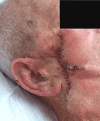Multi-flap Cheek Reconstruction: Merging Triple Advancement, Island Pedicle, and Rotation Flaps for Optimal Aesthetic and Functional Outcomes After Mohs Micrographic Surgery
- PMID: 39575024
- PMCID: PMC11581139
- DOI: 10.7759/cureus.72139
Multi-flap Cheek Reconstruction: Merging Triple Advancement, Island Pedicle, and Rotation Flaps for Optimal Aesthetic and Functional Outcomes After Mohs Micrographic Surgery
Abstract
An 85-year-old white male presented with a basal cell carcinoma on the right cheek, treated with Mohs micrographic surgery, resulting in a 5.8 x 3.2 cm defect across multiple facial subunits. Given the defect's size and patient's age, options such as second-intention healing, primary closure, and skin grafting were deemed suboptimal. The cheek's anatomical complexity requires innovative surgical strategies for large defects. A multi-faceted surgical approach using adjacent tissues was employed: a triple advancement flap, an island pedicle, and a rotation flap to optimize aesthetic and functional outcomes. The defect was primarily closed using a triple advancement technique to minimize the tension and distortion at the lateral canthus and oral commissure. An island pedicle flap was then utilized to close the anterior part of the defect. Finally, a rotation flap and excision of a small standing skin cone allowed repair of the superior defect with minimal distortion of the lateral canthal skin. Key suturing strategies were implemented to maximize skin laxity and minimize aesthetic disruption. By integrating Mohs surgery, multiple flap techniques, and careful tension management, effective closure was achieved with excellent oncologic and aesthetic outcomes. This case underscores the importance of tailored surgical approaches in facial reconstructive surgery, particularly in elderly patients with significant aesthetic and functional considerations.
Keywords: advancement flap; burow's graft; cutaneous oncology; facial reconstruction; mercedes flap; mohs micrographic surgery (mms); mohs surgery; skin rotation flap; tripolar advancement flap; wound reconstruction.
Copyright © 2024, Jacobs et al.
Conflict of interest statement
Human subjects: Consent for treatment and open access publication was obtained or waived by all participants in this study. Conflicts of interest: In compliance with the ICMJE uniform disclosure form, all authors declare the following: Payment/services info: All authors have declared that no financial support was received from any organization for the submitted work. Financial relationships: All authors have declared that they have no financial relationships at present or within the previous three years with any organizations that might have an interest in the submitted work. Other relationships: All authors have declared that there are no other relationships or activities that could appear to have influenced the submitted work.
Figures




References
-
- Ilankovan V, Ethunandan M, Seah TE. Local Flaps in Facial Reconstruction. Cham: Springer; 2015. Facial units and subunits.
-
- Repair of a large cheek defect. Shea K, Potter K, Weinberger C. Dermatol Surg. 2022;48:989–991. - PubMed
-
- The cervicofacial flap. Rhodes R, Moreau A, Romano E, Cannon T. Oper Tech Otolayngol Head Neck Surg. 2019;30:145–150.
-
- Repair of a large mutisubunit temple, zygomatic cheek, and lateral eyelid defect. Nguyen TA, Gharavi NM. Dermatol Surg. 2023;49:283–285. - PubMed
-
- Cottrell J, Raggio BS. StatPearls [Internet] Treasure Island: StatPearls Publishing; 2024. Facial reconstruction for Mohs defect repairs. - PubMed
Publication types
LinkOut - more resources
Full Text Sources
